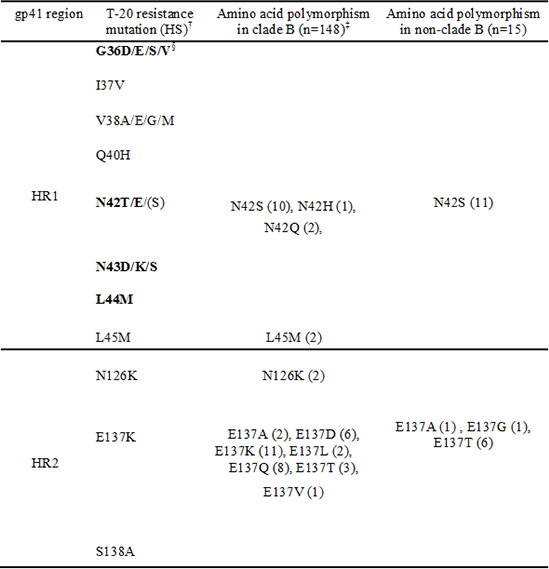1. Gottlieb MS, Schroff R, Schanker HM, Weisman JD, Fan PT, Wolf RA, Saxon A. Pneumocystis carinii pneumonia and mucosal candidiasis in previously healthy homosexual men: evidence of a new acquired cellular immunodeficiency. N Engl J Med. 1981; 305:1425–1431.
2. Kee MK, Lee JH, Whang J, Kim SS. Ten-year trends in HIV prevalence among visitors to public health centers under the National HIV Surveillance System in Korea, 2000 to 2009. BMC Public Health. 2012; 12:831.
3. Kim JY, Kim EJ, Choi JY, Kwon OK, Kim GJ, Choi SY, Kim SS. Genetic variation of the HIV-1 integrase region in newly diagnosed anti-retroviral drug-naïve patients with HIV/AIDS in Korea. Clin Microbiol Infect. 2011; 17:1155–1159.
4. Pessoa LS, Valadão AL, Abreu CM, Calazans AR, Martins AN, Azevedo SS, Couto-Fernandez JC, Azevedo MC, Tanuri A. Genotypic analysis of the gp41 HR1 region from HIV-1 isolates from enfuvirtide-treated and untreated patients. J Acquir Immune Defic Syndr. 2011; 57:S197–S201.
5. Pritsker M, Rucker J, Hoffman TL, Doms RW, Shai Y. Effect of nonpolar substitutions of the conserved Phe11 in the fusion peptide of HIV-1 gp41 on its function, structure, and organization in membranes. Biochemistry. 1999; 38:11359–11371.
6. Morozov VA, Morozov AV, Schürmann D, Jessen H, Kücherer C. Transmembrane protein polymorphisms and resistance to T-20 (Enfuvirtide, Fuzeon) in HIV-1 infected therapy-naive seroconverters and AIDS patients under HAART-T-20 therapy. Virus Genes. 2007; 35:167–174.
7. Kilby JM, Eron JJ. Novel therapies based on mechanisms of HIV-1 cell entry. N Engl J Med. 2003; 348:2228–2238.
8. Johnson VA, Calvez V, Gunthard HF, Paredes R, Pillay D, Shafer RW, Wensing AM, Richman DD. Update of the drug resistance mutations in HIV-1: March 2013. Top Antivir Med. 2013; 21:6–14.
9. Xu L, Pozniak A, Wildfire A, Stanfield-Oakley SA, Mosier SM, Ratcliffe D, Workman J, Joall A, Myers R, Smit E, et al. Emergence and evolution of enfuvirtide resistance following long-term therapy involves heptad repeat 2 mutations within gp41. Antimicrob Agents Chemother. 2005; 49:1113–1119.
10. Bienvenu B, Krivine A, Rollot F, Pietri MP, Lebault V, Meritet JF, Guerin C, Spiridon G, Salmon D, Guillevin L, et al. A cohort study of enfuvirtide immunological and virological efficacy in clinical practice. J Med Virol. 2006; 78:1312–1317.
11. Mink M, Mosier SM, Janumpalli S, Davison D, Jin L, Melby T, Sista P, Erickson J, Lambert D, Stanfield-Oakley SA, et al. Impact of human immunodeficiency virus type 1 gp41 amino acid substitutions selected during enfuvirtide treatment on gp41 binding and antiviral potency of enfuvirtide in vitro. J Virol. 2005; 79:12447–12454.
12. Kim GJ, Yun MR, Koo MJ, Shin BG, Lee JS, Kim SS. Estimating the origin and evolution characteristics for Korean HIV type 1 subtype B using Bayesian phylogenetic analysis. AIDS Res Hum Retroviruses. 2012; 28:880–884.
13. Lohrengel S, Hermann F, Hagmann I, Oberwinkler H, Scrivano L, Hoffmann C, von Laer D, Dittmar MT. Determinants of human immunodeficiency virus type 1 resistance to membrane-anchored gp41-derived peptides. J Virol. 2005; 79:10237–10246.
14. Greenberg ML, Cammack N. Resistance to enfuvirtide, the first HIV fusion inhibitor. J Antimicrob Chemother. 2004; 54:333–340.
15. Johnson VA, Brun-Vezinet F, Clotet B, Kuritzkes DR, Pillay D, Schapiro JM, Richman DD. Update of the drug resistance mutations in HIV-1: fall 2006. Top HIV Med. 2006; 14:125–130.
16. Izumi K, Kawaji K, Miyamoto F, Shimane K, Shimura K, Sakagami Y, Hattori T, Watanabe K, Oishi S, Fujii N, et al. Mechanism of resistance to S138A substituted enfuvirtide and its application to peptide design. Int J Biochem Cell Biol. 2013; 45:908–915.
17. Carmona R, Pérez-Alvarez L, Muñoz M, Casado G, Delgado E, Sierra M, Thomson M, Vega Y, Vázquez de Parga E, Contreras G, et al. Natural resistance-associated mutations to Enfuvirtide (T20) and polymorphisms in the gp41 region of different HIV-1 genetic forms from T20 naive patients. J Clin Virol. 2005; 32:248–253.
18. Teixeira C, de Sá-Filho D, Alkmim W, Janini LM, Diaz RS, Komninakis S. Short communication: high polymorphism rates in the HR1 and HR2 gp41 and presence of primary resistance-related mutations in HIV type 1 circulating in Brazil: possible impact on enfuvirtide efficacy. AIDS Res Hum Retroviruses. 2010; 26:307–311.
19. Hudelson SE, Marlowe N, Huang W, Bruce R, Church JD, Husnik M, Donnell D, Coates T, Jackson JB, Chesney M, et al. Analysis of HIV type 1 gp41 and enfuvirtide susceptibility among men in the United States who were HIV infected prior to availability of HIV entry inhibitors. AIDS Res Hum Retroviruses. 2009; 25:701–705.
20. Aquaro S, D'Arrigo R, Svicher V, Perri GD, Caputo SL, Visco-Comandini U, Santoro M, Bertoli A, Mazzotta F, Bonora S, et al. Specific mutations in HIV-1 gp41 are associated with immunological success in HIV-1-infected patients receiving enfuvirtide treatment. J Antimicrob Chemother. 2006; 58:714–722.











 PDF
PDF ePub
ePub Citation
Citation Print
Print





 XML Download
XML Download